Fascinating ‘The Fabelmans’ explores Steven Spielberg’s family, filmmaking inspirations
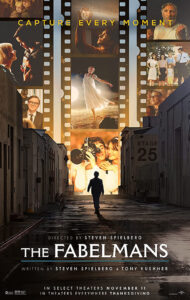 By Steve Crum
By Steve Crum
Had Alfred Hitchcock filmed the story of how he got interested in films, there could have been some very revealing moments. Like his father locking the child Hitch up in a local jail to teach him a lesson. Maybe Hitchcock’s introduction to the element of fear?
Now refocus on Steven Spielberg’s semi-autobiographical (or “auto biopic”) drama, The Fabelmans, co-written and directed by Spielberg. It could well have been titled The Spielbergs, were it a documentary. But The Fabelmans is based upon Steven Spielberg’s childhood, in the process renaming his relatives, including himself. 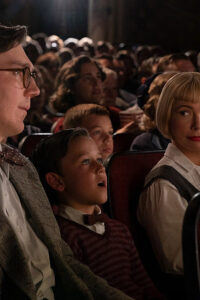 (Steven is “Sammy.”) The project has been over two decades in the making, being green lit once his parents had passed on. He did not want to hurt any feelings.
(Steven is “Sammy.”) The project has been over two decades in the making, being green lit once his parents had passed on. He did not want to hurt any feelings.
The result is an absorbing, revealing motion picture.
As recounted by Spielberg in previous interviews, he was first impacted at the movie theatre as a young boy in 1952. So it is with Sammy Fabelman. After seeing Cecil B. DeMille’s The Greatest Show on Earth, Sammy is awestruck (particularly at the circus train wreck sequence), mesmerized and inspired to duplicate what he had just seen at home. Using his father Burt’s (Paul Dano) 8mm camera, Sammy (Gabriel LaBelle) films his own silent version of crashing his newly acquired train set. His mother, Mitzi (Michelle Williams) encourages Sammy to pursue his new hobby, while his father is discouraging.
Sammy’s filming continues on a larger scale, sometimes including his three younger sisters in the shooting.
After the family has to move to another state due to Burt’s job, Sammy continues his amateur filmmaking—even including his fellow Boy Scout troops as extras in battle scenes.
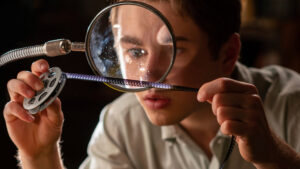 Sammy makes filming family outings, such as a camping trip, an occasion wherein he directs the action with experimentation of lighting and angles. Also involved in family activities is his father’s best friend and associate, Benny Loewy (Seth Rogen), whose presence-particularly during Sammy’s teen years—segues from jocular “uncle” to disruptive interloper.
Sammy makes filming family outings, such as a camping trip, an occasion wherein he directs the action with experimentation of lighting and angles. Also involved in family activities is his father’s best friend and associate, Benny Loewy (Seth Rogen), whose presence-particularly during Sammy’s teen years—segues from jocular “uncle” to disruptive interloper.
In the process, Sammy becomes more enamored with someday making a living creating movies. This is still much to his dad’s chagrin.
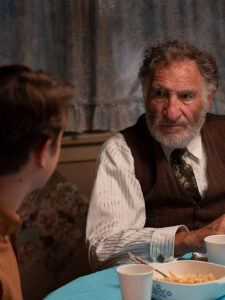 There is a wonderful performance by Judd Hirsch as Boris Podgorny, a granduncle and ex-film worker and circus lion tamer. He is a character for sure, but encourages Sammy to pursue his dreams with the realization of their conflict with family expectations. Such is the crux of The Fabelmans.
There is a wonderful performance by Judd Hirsch as Boris Podgorny, a granduncle and ex-film worker and circus lion tamer. He is a character for sure, but encourages Sammy to pursue his dreams with the realization of their conflict with family expectations. Such is the crux of The Fabelmans.
The film pivots when Sammy discovers a jarring secret while editing some family camping footage.
That said, a major change occurs when dad’s job forces him to move to Southern California—the land of sunshine and movies. Sammy’s dream world enlarges as the reality of his parents’ marriage is endangered.
The screenplay also covers Sammy’s encounters with anti-semitism, his college years, love life, and early TV production work.
Incidentally, a must-see is Sammy’s encounter with John Ford (played by director David Lynch), which is pretty much what occurred when Steven Spielberg first met the crusty director.
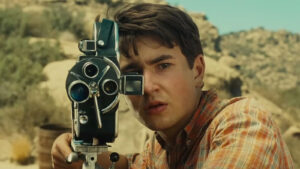 Overall, The Fabelmans is a unique telling by one of the most popular directors in cinema history.
Overall, The Fabelmans is a unique telling by one of the most popular directors in cinema history.
∞∞∞∞∞
GRADE on an A-F Scale: A-
∞∞∞∞∞
Memorably messy ‘White Noise’ makes it must-see-to-believe
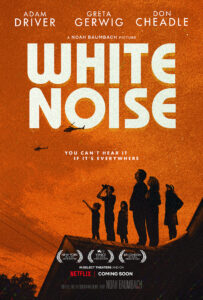 By Steve Crum
By Steve Crum
The plot is both the least to worry about as well as the least to understand in White Noise. After sitting through its 136 minutes, I am mesmerized. To call White Noise unconventional is to put it, well, mildly. It is a fragmented mess of a plot, yes. It is wildly a spectacle, yes.
See it.
 One need only check Noah Baumbach’s film credentials to nod yes to describing White Noise. He is pretty much the auteur behind it. Baumbach directs, produces, and writes the screenplay. He has cast past collaborators Greta Gerwig and Adam Driver as the leads. Even though Wes Anderson is not part of the production team this time, White Noise has Anderson overtones.
One need only check Noah Baumbach’s film credentials to nod yes to describing White Noise. He is pretty much the auteur behind it. Baumbach directs, produces, and writes the screenplay. He has cast past collaborators Greta Gerwig and Adam Driver as the leads. Even though Wes Anderson is not part of the production team this time, White Noise has Anderson overtones.
Baumbach has been compared to Woody Allen in individualizing his movies, and so goes this film. Yet it maintains the distinctive Baumbach stamp. Consider his stylistic works The Squid and the Whale and Marriage Story.
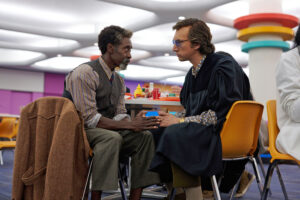 A plot description paints a quirky picture of the way off kilter central family that evolves into a dark comedy full of whacky characters behaving under multiple life or death circumstances.
A plot description paints a quirky picture of the way off kilter central family that evolves into a dark comedy full of whacky characters behaving under multiple life or death circumstances.
Where to begin? Why not start in 1984 with Jack Gladney (Adam Driver), a professor of “Hitler Studies” at a small college in Ohio. By the way, Jack does not speak German—a growing concern since he is scheduled to give a speech at an upcoming conference where he is expected to sprechen Deutsch. It makes Baumbach sense that Jack’s best friend is his colleague, Prof. Murray Siskind (Don Cheadle), who is encouraged by Jack to develop a course in “Elvis Studies.”
Back on the home front, Jack is married to his fourth wife, Babette (Greta Gerwig). They are raising a very blended family of four children.  Older daughter Denise (Raffey Cassidy) catches her mother using a secret prescription of Dylar, a “mysterious drug,” as the story segues into nightmarish dreams of death experienced by Jack.
Older daughter Denise (Raffey Cassidy) catches her mother using a secret prescription of Dylar, a “mysterious drug,” as the story segues into nightmarish dreams of death experienced by Jack.
Death is literally in the air when a nearby train derailment casts a cloud of toxic fumes over the quaint college town, and the entire city is forced to evacuate. Cut to long traffic lines inching along, including the car of Jack, Babette and family. There is also a potential tragedy in the works here. (There is also a memorable sequence wherein the Gladney car is converted to a water raft.)
During the third movie’s wild third act, things have moved on to paranoia, death anxieties, and murder threats at a motel.
 But never fear? Without divulging too much, be advised to pay attention to the entire credit roll, which includes some checkout lanes at a vintage store…and a singable-danceable tune by Danny Elfman. Strangely, this finale sequence really sold me on White Noise.
But never fear? Without divulging too much, be advised to pay attention to the entire credit roll, which includes some checkout lanes at a vintage store…and a singable-danceable tune by Danny Elfman. Strangely, this finale sequence really sold me on White Noise.
∞∞∞∞∞
GRADE on an A-F Scale: B
A sad remembrance of Louisiana’s Polk Theatre & ‘GWTW’
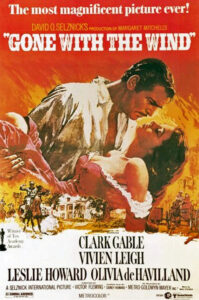 By Steve Crum
By Steve Crum
A few months into 1970, after being drafted into the Army, I found myself stationed at Fort Polk, Louisiana. Basic Training at Leonard Wood in Missouri was history. It was summer. I heard that the local Leesville movie theatre, the Polk, was running a re-release of a movie I had never seen before, Gone With the Wind. The 1939 film is legendary, having won multiple Academy Awards.
Even then I was a true movie buff, yet I had missed seeing GWTW all my life. The only way to see it those days was via an MGM re-release, a booking at select theatres across the country—for a limited time of perhaps one week. Then the 35 mm reels would be shipped back to the MGM vault for yet another release in maybe five years. And so on.
These were the days of no DVD, no VHS, no cable TV, and no streaming channels. We had only small screen TVs operating on tubes. So I decided to see it where it was made to be seen—on a large screen.
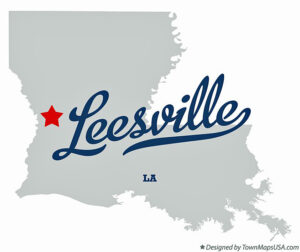 Alone I drove to the Polk (none of my buddies cared about the movie), paid my admission, and sat in a half-full house in a main floor aisle seat, center section. In front of me, a junior high history teacher and her 15 or so students sat. She reminded them that what they were going to see is a history of the South, and to pay attention quietly. A “history of the South”? I was amused. GWTW is a documentary?!
Alone I drove to the Polk (none of my buddies cared about the movie), paid my admission, and sat in a half-full house in a main floor aisle seat, center section. In front of me, a junior high history teacher and her 15 or so students sat. She reminded them that what they were going to see is a history of the South, and to pay attention quietly. A “history of the South”? I was amused. GWTW is a documentary?!
The Polk was a typical neighborhood theatre showing its age. But it had a large screen and OK speakers. I watched the lengthy movie, and enjoyed it. MGM had supplied a very good print.
Most of the audience, including the history class, had exited by the time the finale music ended. Then I left.
Walking to my car, I noticed a somewhat long line waiting a few yards away at a different door than I had entered. I asked someone what was going on. “Oh, they’re in line to see Gone With the Wind. That’s the Colored line. They sit  upstairs in the balcony.” Hmm. Come to think of it, there were only Whites seated around me. I did notice there was a small balcony, but then paid it no attention.
upstairs in the balcony.” Hmm. Come to think of it, there were only Whites seated around me. I did notice there was a small balcony, but then paid it no attention.
Note that there was no sign posted like “Whites Only” or “Coloreds Only.” This was more subtle, more locally understood…
Racism.
I never returned to the Polk Theatre. Nor will I ever forget it.
∞∞∞∞∞
The Polk Theatre closed a few decades ago, and is now a church. (See photo.)
‘Elvis’ has Oscar tinsel all over it, from acting to direction
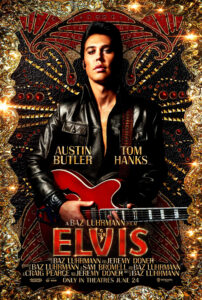 By Steve Crum
By Steve Crum
Elvis should be renamed Baz Luhrmann’s Elvis. Like Luhrmann’s previous movies Moulin Rouge! and The Great Gatsby, the distinctive film auteur (director/producer/screenwriter) showcases Elvis in a dazzling opulence of color, set design, and musical presentations. How appropriate for the story of Elvis Presley, himself a socko entertainer, arguably the greatest of all-time.
In some ways, Elvis is the most accurate movie musical biography ever produced. First, it covers Presley’s life—from birth to death (1935-77). Jamie Foxx’s incredible performance as Ray Charles in 2004’s Ray should be mentioned in the same breath. That is because both Foxx and Austin Butler (who portrays Elvis) are both near soundalikes via their respective voices and body language.
Lesser breadth is found in two other popular movie bios about great showbiz stars—Fanny Brice (1968’s Funny Girl & 1975’s Funny Lady); and Al Jolson (1946’s The Jolson Story and 1949’s Jolson Sings Again). In both the Brice and Jolson movies, the chronological order of their lives as well as factual accuracy are often revised or entirely absent.
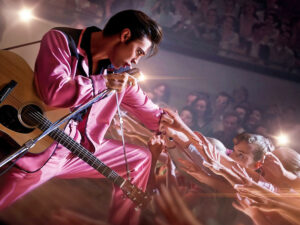 Brice is played by Barbra Streisand, who does not look or sound at all like Brice. Larry Parks as Jolson has the performance movement down quite well, but has to lip sync Jolson’s previously recorded songs. Correction: He perfectly lip syncs. And he does not even come close to Jolie in facial look.
Brice is played by Barbra Streisand, who does not look or sound at all like Brice. Larry Parks as Jolson has the performance movement down quite well, but has to lip sync Jolson’s previously recorded songs. Correction: He perfectly lip syncs. And he does not even come close to Jolie in facial look.
That ALL said, Austin Butler actually sings, resembles, and moves like Presley. And he is a fine actor to boot. Uncanny is the appropriate description.
Contrasting to Butler’s super performance, there is Tom Hanks. The jury is mixed on Hanks’ performance. As Presley’s long-time manager Col. Tom Parker, Hanks has had facial prosthetics and body padding added to make him look somewhat like Parker. And he appropriately speaks with a heavy Dutch accent, trying to emulate.  The result is a mixed bag. I could not entirely get past the fact that it is really Hanks. Sometimes yes, sometimes no.
The result is a mixed bag. I could not entirely get past the fact that it is really Hanks. Sometimes yes, sometimes no.
I suppose it is appropriate that Luhrmann repeatedly pictures Parker lurking in the shadows or peeking around a curtain—to spy on Elvis. No subtlety here.
Luhrmann’s Elvis saga (159 minutes) begins long after Elvis’ death as the elderly Col. Parker is on his own deathbed. As he struggles to breathe, he begins recalling how he discovered Elvis. Flash back to the youthful Elvis is growing up with his beloved Mama (Helen Thomson) and Daddy (Richard Roxburgh) as among the poor in Mississippi. Elvis is greatly influenced by his African-American friends and neighbors via attending their church and gospel singing.
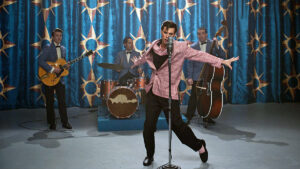 Flip to Col. Parker who is honing his huckster talents as a carnival sideshow barker. While Presley is growing up and partnered with Hank Snow (David Wenham), he is breaking out with his own style adapted from friend B. B. King (Kelvin Harrison Jr.) and others. By the way, there are several terrific musical performances by imitators Gary Clark Jr. (as Arthur “Big Boy” Crudup), Yola (Sister Rosette Tharpe), Alton Mason (Little Richard), and Shonka Dukureh (Big Mama Thornton).
Flip to Col. Parker who is honing his huckster talents as a carnival sideshow barker. While Presley is growing up and partnered with Hank Snow (David Wenham), he is breaking out with his own style adapted from friend B. B. King (Kelvin Harrison Jr.) and others. By the way, there are several terrific musical performances by imitators Gary Clark Jr. (as Arthur “Big Boy” Crudup), Yola (Sister Rosette Tharpe), Alton Mason (Little Richard), and Shonka Dukureh (Big Mama Thornton).
Throughout the film, 36 Presley hits are sung (via Butler)…from “That’s All Right” to “Hound Dog” to “Can’t Help Falling in Love” to “Heartbreak Hotel” and on and on.
Recreations of landmark Presley performances cover The King in Las Vegas; on TV as a guest (The Steve Allen Show and others); in his many  movies as shown in snippets (a collage of his Paramount musicals); and during his TV Specials. The most humorous recreation is a Christmas Special wherein Elvis famously defies his advertisers and his manager, the not-so-good Colonel.
movies as shown in snippets (a collage of his Paramount musicals); and during his TV Specials. The most humorous recreation is a Christmas Special wherein Elvis famously defies his advertisers and his manager, the not-so-good Colonel.
Elvis’ personal life includes virtually every aspect from his love for his mother, his marriage to Priscilla, his tenure in the Army, his buddies who travel and live with him at Graceland, and finally his tenure at The International in Vegas. Throughout, Col. Parker wheels, deals, and manipulates Elvis’ professional and personal life.
This is an epic story told against a backdrop of wealth, tragedy, rhinestones and showbiz. 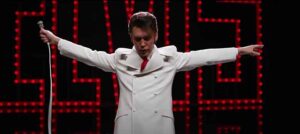 Certainly, Elvis is among the best musical biographies ever produced.
Certainly, Elvis is among the best musical biographies ever produced.
∞∞∞∞∞∞∞∞∞∞
GRADE on an A-F Scale: A-
Fascinating, emotional ‘Good Night Oppy’ is documentary extraordinaire
 By Steve Crum
By Steve Crum
Thirty minutes into the documentary, Good Night Oppy…and I am sobbing. The true story of a NASA mechanical land rover affects one’s tear ducts? Indeed so.
Before delving into the why, what and where, please do not confuse Good Night Oppy with the 2005 Pixar animated WALL-E. I initially DID confuse them. Both films feature a central robot that are similar enough in looks that they could be mechanical brothers. And both are essentially stranded on a planet. Although “Oppy” (a nickname for the rover) is definitely a non-emotional machine, WALL-E has feelings.
Oh, and WALL-E is relegated to a futuristic, devastated Earth. Oppy ’s beat is Mars.
During director Ryan White’s work, which runs 105 minutes, we follow NASA’s early plans to create two land rovers with the capability of being rocketed to Mars, safely landing, and triggered to begin moving around the planet’s landscape to photograph Mars. Soil, rock and atmospheric readings would then be sent back to earth for study.
 With a two-year deadline to a 2003 blast-off from earth, scientists are pressured to construct, test and re-test both rovers. The Viking mission will require two rockets with one rover each. Christened Opportunity and Spirit, the identical units are built to somewhat resemble human beings.
With a two-year deadline to a 2003 blast-off from earth, scientists are pressured to construct, test and re-test both rovers. The Viking mission will require two rockets with one rover each. Christened Opportunity and Spirit, the identical units are built to somewhat resemble human beings.
Each flight lasted approximately six months, and each successfully landed the rover cargo. Meant to last 90 days each, the two Mars rovers surprised NASA engineers by exceeding that time. In Opportunity’s case, it was able to rove and send data to earth for an incredible 15 years!
This beautifully imagined film includes both archival footage as well as realistic computerized re-creations via Industrial Light & Magic. The  latter, particularly when we follow Oppy’s trek across rough Martian terrain to find water, make up the breadth of Good Night Oppy’s awesome imagery.
latter, particularly when we follow Oppy’s trek across rough Martian terrain to find water, make up the breadth of Good Night Oppy’s awesome imagery.
 Over the course of this film, it is impossible not to join NASA scientists as they become increasingly emotionally involved with Oppy and its/his amazing abilities.
Over the course of this film, it is impossible not to join NASA scientists as they become increasingly emotionally involved with Oppy and its/his amazing abilities.
The story, by Helen Kearns and Ryan White, is narrated by Angela Bassett. The Blake Neely score is peppered with pop recordings by The Beatles, Wham, ABBA, and more—songs played each morning by NASA to “wake up” their land rovers.
Oppy’s journey is never-to-be-forgotten…thanks in large part to the remarkable Good Night Oppy.
∞∞∞∞∞∞∞∞∞∞
Grade on an A-F Scale: A
